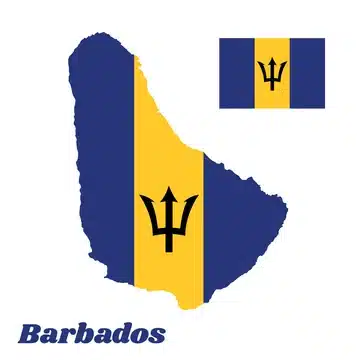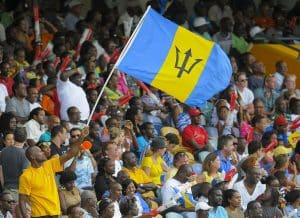Headlines
Barbados Population, Official Language And More.

The island was first called ‘Los Barbados’ by the Portuguese who visited in 1537, because of the bearded fig trees they saw.
The first inhabitants were Amerindians, mainly Arawaks and Caribs, who came from South America.
The Spanish and Portuguese claimed the island in the 16th century but did not settle it. They enslaved and deported many of the natives.

Barbados
The Population
Barbados is a small island nation with a population of about 287,000 people as of 2020. The majority of the population is of African descent (92.4%), followed by mixed (3.1%), white (2.7%), Indian (1.3%), and other (0.5%). The population is mostly urban, with about 40% living in or around the capital city of Bridgetown. The population growth rate is low, at 0.12% per year, due to low fertility and high emigration.
The Landmarks
Barbados has many natural and historical landmarks that attract tourists and locals alike. Some of the most famous ones are:
Harrison’s Cave: a limestone cave system with stalactites, stalagmites, streams, and pools.
Animal Flower Cave: a sea cave with colorful anemones and coral formations.
Mount Hillaby: the highest point on the island, offering panoramic views of the countryside.
St. Nicholas Abbey: a 17th-century plantation house and museum with a rum distillery.
George Washington House: the only house outside the US where the first American president stayed in 1751.
The Official Language
The official language of Barbados is English, which is used for formal settings and written communications. However, most Barbadians also speak Bajan, an English-based creole language that is influenced by West African languages. Bajan has its own vocabulary, grammar, and pronunciation, and is used for informal settings and everyday conversations. Some examples of Bajan words and phrases are:
Wuh yuh sayin?: What are you saying? / How are you?
Chees on bread: An exclamation of surprise or frustration
Lickrish: Greedy
Liming: Hanging out with friends
Wukking up: Dancing in a suggestive way
The Culture
The culture of Barbados is a blend of West African and British cultures, reflecting its history of slavery and colonialism. Some aspects of the Barbadian culture are:
Music: Barbados is known for its music genres such as calypso, spouge, soca, and reggae. It is also the birthplace of pop star Rihanna.
Cuisine: Barbadian cuisine is based on seafood, meat, rice, vegetables, and spices. Some of the national dishes are cou-cou (cornmeal and okra), flying fish (fried or steamed), and pudding and souse (pickled pork and sweet potato).
Festivals: Barbados celebrates many festivals throughout the year, such as Crop Over (a harvest festival), Holetown Festival (a commemoration of the first settlement), and Independence Day (November 30).
Sports: Barbados is passionate about sports, especially cricket, which is the national sport. Other popular sports are soccer, rugby, golf, and surfing.
The Economic Stability
Barbados has a stable and diversified economy that relies on tourism, manufacturing, and financial services. It has a high human development index, a low poverty rate, and a high literacy rate. However, it also faces some challenges such as high public debt, vulnerability to natural disasters, and dependence on imported goods. In recent years, Barbados has implemented an economic recovery plan with the help of the International Monetary Fund (IMF) to restore fiscal sustainability, increase reserves, and unlock growth potential through structural reforms.
The GDP
The Gross Domestic Product (GDP) of Barbados is the measurement of the total value of goods and services produced in the country in a year. According to the World Bank, the GDP of Barbados was worth 5.64 billion US dollars in 2022. This represents less than 0.01 percent of the world economy.
The Currency
The currency of Barbados is the Barbadian dollar (BBD). One dollar is divided into 100 cents. The Barbadian dollar is fixed to the US dollar at a rate of 2 BBD = 1 USD2. Bank notes are available in 2, 5, 10, 20, 50 and 100 bills.
The Food
Barbados has a rich and diverse cuisine that reflects its history, culture and natural resources. Some of the traditional food in Barbados are:
| Food | Description |
|---|---|
| Rum Cake | A moist cake soaked in rum and topped with dried fruits and nuts |
| Cou-cou | A national dish made of cornmeal and okra cooked with butter and water |
| Flying Fish | A fish that can glide over the water, often fried or steamed and served with cou-cou |
| Conkies | A sweet treat made of grated pumpkin, coconut, spices, sugar and currants, wrapped in banana leaves |
| Bakes | A fried bread that can be eaten plain or with cheese, fish or meat |
Major Cities
Barbados is a small island nation with an area of 439 square kilometers (169 square miles). The capital and largest city is Bridgetown, which has a population of about 110,000 people. Other major cities include Speightstown, Holetown, Oistins and Bathsheba.
Major Airport, Sea Port and Schools
Barbados has one international airport, the Grantley Adams International Airport (BGI), located in Seawell, Christ Church. The airport serves as a hub for regional and international flights.
Barbados has one major sea port, the Bridgetown Port, located in the capital city. The port handles cargo and cruise ships from around the world.
Barbados has a high literacy rate of 99.7 percent and a well-developed education system. Some of the major schools in Barbados are:
The University of the West Indies Cave Hill Campus
The Barbados Community College
The Samuel Jackman Prescod Institute of Technology
The Codrington School
The Harrison College





